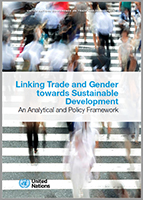
This volume draws from country and regional case studies to illustrate how trade and gender are connected through a reciprocal relation, and how these issues are being addressed within trade policy circles.
Trade and trade policy influence economic outcomes such as employment, income, wages, working conditions, consumption, tax burden. Men and women are affected differently in the distinct economic roles they play (e.g., workers, producers, small entrepreneurs, traders, consumers, taxpayers), which contributes to shape overall gender equality. This is one side of the two-way relation between trade and gender discussed in this volume.
On the other side of the two-way relation, gender inequalities rooted in different domains of economic and social life influence a country’s competitiveness and export performance: gender-based disadvantages can be either exploited by firms to enhance their export competitiveness or can act as barriers to women’s capacity to export and run their businesses successfully.
The reciprocal relation between trade and gender has started to receive increased attention in policy circles.
Those responsible for trade policy have moved from being gender-blind to increasingly recognizing the differential impacts of trade on men and women, and the need to respond to them. Gender considerations are being integrated into and/ or mainstreamed in trade policy, for instance through ex-ante gender impact assessment of trade policy, or through the introduction of gender provisions in trade agreements. Within the WTO, important steps have also been taken to advance the trade and gender agenda.
Through this volume, readers should be able to:
- Illustrate the transmission channels through which trade affects women as workers, entrepreneurs and consumers.
- Illustrate the transmission mechanisms through which gender inequalities affect trade performance and a country’s trade competitiveness.
- Describe different approaches to ex ante gender impact assessment of trade policy.
- Compare the ways through which gender provisions are introduced in trade agreements and assess their likely effectiveness.
- Assess the developments at the WTO regarding gender mainstreaming in trade policy.
- Formulate proposals to make any given country’s trade policy more gender responsive.
This publication constitutes the basis of the online courses on trade and gender organized by UNCTAD’s Trade, Gender and Development Programme.




